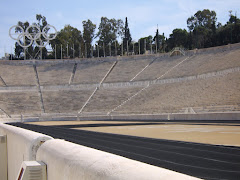When trekking through Chicago, disappointment of "what could have been" (2016 Olympics) still crosses my mind. That October morning beside the Picasso sculpture and City Hall was a bummer.
But with each return to Chicago, new memories get forged, and the Chicago Art Institute's outstanding current exhibition "Picasso And Chicago" provided a great bridge to new cheer about the windy city and its rich ties to art and art history.
Chicago's Picasso show was not the first experienced in early 2013 -- a couple months ago the Guggenheim's P.R. team arranged tickets for "Picasso Black and White" (excellent). The Chicago exhibition rounded out a lot of the Picasso story for me, showcasing career details that did not previously resonate.
For instance, I had no idea Picasso created hundreds of ceramic items in one year of focus on this medium. "Picasso And Chicago" includes several examples, including a beautiful and tall work with four human figures (a modern take on the Greek urns on loan from the British Museum a couple of galleries from the special exhibition space).
Picasso also wrote hundreds of poems and two plays, creating illustrations to bring some of these works to life on paper or canvas. His tiny drawings are simply amazing in their detail.
The Art Institute show also taught more about Picasso's love life and the women who influenced the artist.
I loved discovering (spoiler alert) that when Chicago's mayor travelled to meet Picasso about the City Hall sculpture commission, the politician brought along works by famous Chicago-born artists, prompting Picasso's excited reaction (paraphrasing here), "Hemingway -- my friend! He's from Chicago?" and comments about how the master painter taught the master writer "everything he knows about bullfighting."
The exhibition is bookended by the history of Chicago's most famous sculpture, with the entryway showcase of a bronze model of the work, flanked by "The Blue Guitar" and speakers broadcasting news interviews from the sculpture unveiling event in downtown Chicago (as today, folks on the first day shared candid comments spanning the spectrum from instant love to perplexed reactions to the work).
One work stood out for this blogger -- "Peasant Woman With A Shawl" -- presented as the first Picasso that Chicago and American audiences viewed in the artist's first USA exhibition. A handful of massive canvases, several two-faced female portraits, and several of Picasso's 2,500+ prints round out the exhibition (250 works in all -- my head was spinning in a good way).
For those who visit "Picasso And Chicago" be sure to pick up the audio tour and museum card highlighting several additional Picasso that are in the museum but not included in the exhibition.
Many thanks to the Art Institute for setting up the blogger tickets. Many new happy memories forged in Chicago.
Now if we can just convince the mayor of Chicago to pursue the 2024 Olympic bid ...
Photos by Nicholas Wolaver
Olympic Fencer Cleared of Doping Charge as Panel Determines Kissing Her
Boyfriend Was the Likely Cause
-
Ysaora Thibus was facing a four-year suspension from fencing before the
appeal was dismissed
5 days ago








.jpg)






























